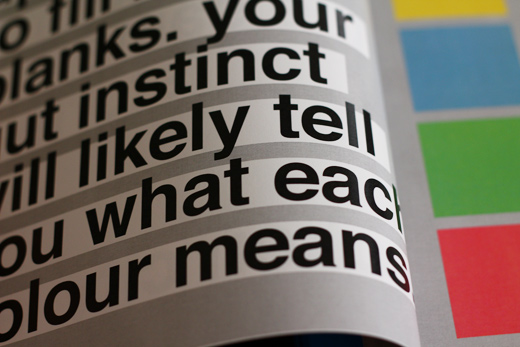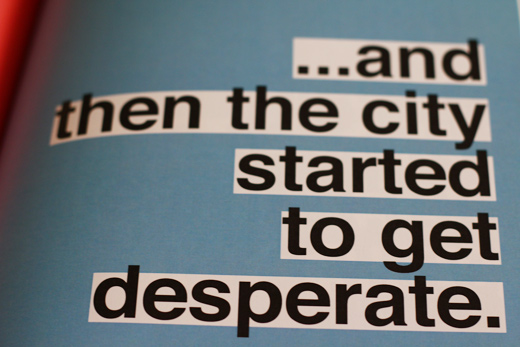
A little while ago, we were trying to think through how to wrap up Save the City with a pair of billboards. We spent an evening really working through some ideas and came up with two statements that we felt articulated the end of a certain way of thinking about Windsor.
Something about those statements really struck me. While we had come up with a number of other instances of “…and then the city” lines, we could only get two of them up on the billboards and it seemed like these statements were actually the beginning of a larger idea.
So, I put together a book of 100 statements. You can see some of the pages after the break.
If you’d like a copy, you can order it from Blurb.

I titled the book, “…and then the city: brand new endings for cities telling the same old stories.”

The pages inside are colour coded, though it’s up to you to describe the colours in order to provide a level of categorization for the statements.

Certainly, I assigned certain texts to certain colours that I felt were suggestive of how the statements translate in a given city, but ultimately there are subtitles that you can provide to those colours that actually gives these ideas significantly more depth.

The spine of the book.

There isn’t particularly a reference point in time for each page (that is, within Windsor or really even generally in terms of a history of the idea of the North American city). Instead, each page creates a landing point in what seems to be the cyclical nature of cities — hope, failure, bad decisions, nostalgia, construction, sprawl, gentrification, isolation, devotion, etc.

Often, the statements personify the city, which gives room for a nuanced consideration of the text, I think.

Some are directly ascribing impossible characteristics to a city.

Others attempt to complicate the assumptions we make in regards to the way a city bureaucracy works (or, rather, doesn’t).

I’ve really enjoyed hearing how people assign certain attributes to each colour, sometimes similar in sentiment to the way I imagined them, and at other times, significantly more invested.

The book has 102 pages in it.

And there’s an ending of sorts, I suppose, though to be clear, the page above isn’t it. I’m very interested in how these texts can provide room for a reader to consider the implications thereof on a place like Windsor. Not that these statements are necessarily entirely specific to Windsor — though certainly, I think one could look at nearly any scale of time and find a reference point for nearly every one of them. Again, there’s a cycle in the dynamics of a place, and this book offers endings (or maybe break points is more correct) to these cycles, hopefully giving enough room to consider what led to those endings in the first place.

I’m so happy to cee the city and it’s people making beautiful things. I miss you, city!
Emily, you’re a sweetheart.
The city misses you too!
…and then the city, a book | http://bit.ly/l65iUN